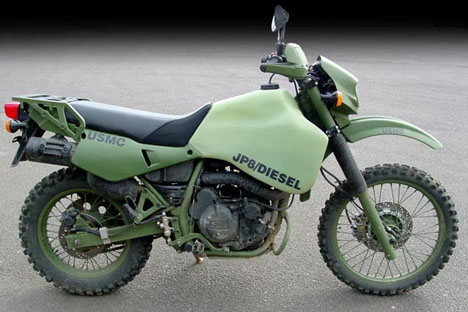Military Motorcycles, Part 3: The Modern-Day Decline

Nearly seventy years after the end of World War II, motorcycles still have a place in the military, however tiny. They're still a fast, nimble way to transport crucial documents or personnel (forward observers and artillery spotters, for instance) from point to point. But the relatively fat Harley WLAs and sidecar-carrying BMWs are a thing of the past, replaced by more agile off-road bikes.
In the 1980s Harley-Davidson acquired a manufacturer named Armstrong and took over production of their MT500 military bikes. In the '90s, H-D released a smaller version called the MT350 (pictured up top), which was purchased by the Canadian and British militaries. There is an unembeddable video of a British soldier introducing the bike here, and as you can see, it's vastly different from the WLA we looked at earlier.
One problem with the MT500 and MT350 is that they run on gasoline; for reasons of resupply logistics, the U.S. military prefers diesel. By the mid-2000s, the U.S. Marine Corps was using Kawasaki KLR650 off-road bikes that run on diesel fuel, seen here:

 According to this site: "Marines from the 26th Marine Expeditionary Unit prepare to load their M1030 motorcycles into a CH-46E Sea Knight helicopter on the flight deck of the amphibious assault ship USS Kearsarge (LHD 3) during flight operations in the Mediterranean Sea on 18 April 2005."
According to this site: "Marines from the 26th Marine Expeditionary Unit prepare to load their M1030 motorcycles into a CH-46E Sea Knight helicopter on the flight deck of the amphibious assault ship USS Kearsarge (LHD 3) during flight operations in the Mediterranean Sea on 18 April 2005."According to this site: "Marines from the 26th Marine Expeditionary Unit prepare to load their M1030 motorcycles into a CH-46E Sea Knight helicopter on the flight deck of the amphibious assault ship USS Kearsarge (LHD 3) during flight operations in the Mediterranean Sea on 18 April 2005."
The video below shows their training facility in California, and features instructor and Gunnery Sergeant Bryon Schmidt—noted as one of two Marines to ride from Kuwait to Baghdad on a motorcycle during Operation Iraqi Freedom—discussing the problem with riding into combat situations:
As you can guess, those Kawasakis aren't store-bought models. The Marine Corps contracted two firms, F1 Engineering Inc. and Hayes Diversified Technologies, to modify them as seen in this mini-doc:After F1 and Hayes are done with the mods, military lingo rebrands the bike with a new designation, the M1030. Or at least, did; the video above is from 2008, and as of today, the former company's website no longer mentions military motorcycles, and the latter's website has shut down altogether.
One poster in an online forum, who appeared to be active duty but declined to communicate with me, posted that the USMC has a fleet of 400 motorcycles used only for communications (in case of radio failure) but never for tactical operations. Other online forums claim Special Forces have access to motorcycles, and while I'd love to corroborate that, I think returning a design blogger's e-mail query is probably not a priority for the Green Berets and Navy SEALs. But whatever the case, motorcycles no longer appear to occupy the same space they once enjoyed, at least in the U.S. military.
Harley-Davidson produced 88,000 military motorcycles during World War II, a far cry from the alleged 400 Kawasakis now on active duty. It's doubtful that H-D feels the sting; they do a brisk business selling bikes to police departments around the world, selling to 45 different countries. "There is something undeniably right," the company writes, "about a cop on a Harley-Davidson."
 Dare you to knock these over, domino-style
Dare you to knock these over, domino-styleDare you to knock these over, domino-style
Military Motorcycles:
» Part 1: WWII and Harley-Davidson
» Part 2: WWII and BMW
» Part 3: The Modern-Day Decline
» Part 4: Andy Keel's Motocrossboard as a Possible Alternative?
-
oFavorite This
-
Q1Comment
K
{Welcome
Create a Core77 Account
Already have an account? Sign In
By creating a Core77 account you confirm that you accept the Terms of Use
K
Reset Password
Please enter your email and we will send an email to reset your password.


Comments
http://www.americanspecialops.com/photos/combat-controllers/combat-controller-motorcycle.php
Note the official career tasks for the Combat Control career field:
http://www.airforce.com/careers/detail/combat-control-males-only/